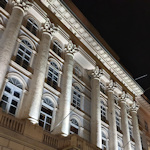
The Palais Niederösterreich holds a special place in Viennese history as the site of a revolution, birthplace of a republic, and host to famous musicians.
- 16th-century palais redesigned in the 19th century
- Some gothic and renaissance areas still preserved inside
- Liszt, Beethoven, and Schubert performed here
- Rarely fully open to the public except at seasonal markets and other special events
- Book a concert experience* for your trip
- See also:
Politics & music
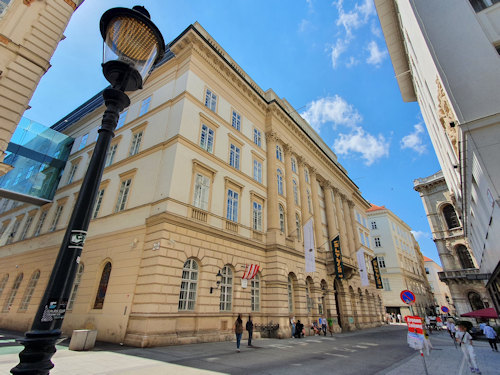
(Hard to get the front on camera without zooming out)
Palais Niederösterreich boasts quite a history; the revolution of 1848 began inside, for example.
Continuing the theme of political change, the first session of the post-WWI government took place here in late 1918. And the palais also hosted the 1945 negotiations that preceded the establishment of the second Austrian republic.
The building itself traces its origins to the early 16th century, when the original house was converted for use as a Vienna base for representatives from the province of Lower Austria (German: Niederösterreich…hence the name).
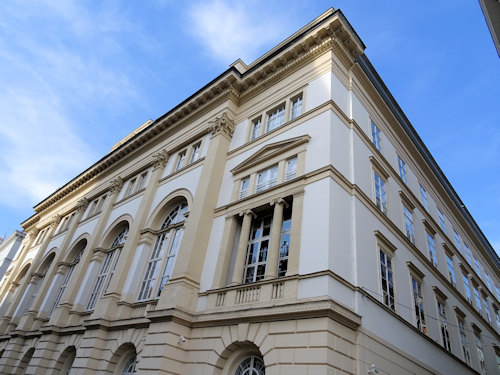
(Rear view of the palais)
Various extensions and rebuilding works have left only a few remnants from the original building; most of the current external appearance stems from the middle of the 19th century.
Curiously, the top two floors are modern office roof extensions, but cunningly designed so you cannot see them from ground level.
The true majesty of Palais Niederösterreich only reveals itself inside, thanks to some rather spectacular and historic rooms.
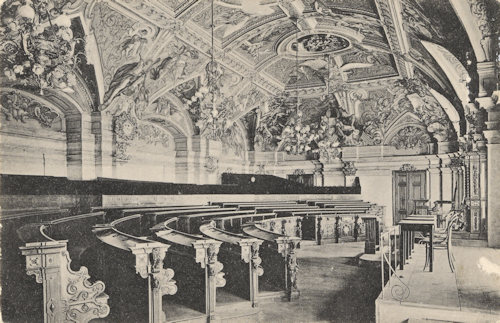
(The Landtagssaal in a photo produced around 1907 by C. Ledermann jun.; Wien Museum Inv.-Nr. 58891/88; reproduced with permission under the terms of the CC0 licence)
For example:
- A gothic chapel with beautifully-shaped rib vaults
- An original renaissance chamber from 1572 with its carved wooden portal, giant caryatids, and a stunning wooden ceiling replete with gilded coats of arms from the reign of Emperor Maximilian II
- The Landtagssaal, constructed during the renaissance and famous for its baroque ceiling frescoes
The Landtagssaal regularly hosted concerts at a time when Vienna had no dedicated concert venue (this all changed with, for example, the construction of the Musikverein).
Apparently, Franz Liszt performed there (as a child) in 1822 and Beethoven, too, and at least one Schubert work first saw the light of day within the palais.
Incidentally, the original connection to Lower Austria was never lost. In fact, the building only ceased to be the home of the provincial parliament in the late 1990s (the parliament still owns the building).
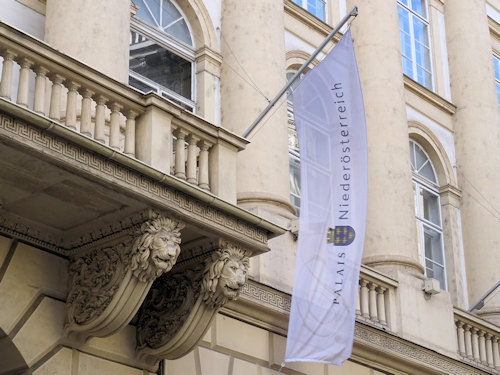
(Part of the front entrance portal)
Tickets & visitor tips
First, the bad news.
Palais Niederösterreich is not normally fully open to the public. It’s a private event location and partly occupied by the Austrian Federal Ministry for Europe, Integration and Foreign Affairs.
The good news is that, as an event location, it occasionally hosts public events. Try the Christmas market in particular. And I’ve seen the palais open for European Heritage Day, too
All such events give you a chance to see several of the historical rooms, and accompanying tours get you into, for example, that remarkable renaissance chamber.
The palais also houses Kunstraum Niederoesterreich, which puts on a handful of art exhibitions in a wing of the palais each year (with free entry).
When you’re there, be sure to pop over the street to Café Central: an absolutely gorgeous coffee house with equally breathtaking interiors.
How to get to Palais Niederösterreich
The palais is easy to reach. Herrengasse starts at one end of the Hofburg palace, so you’re probably passing it as you view the central sights. But if you want to travel direct:
Subway: The U3 line stops at Herrengasse. Unsurprisingly, go out through the Herrengasse exit and you’re a few steps from the palais.
Tram/bus: Herrengasse also has a bus stop, serviced by the 1A and 2A bus lines that twist their way through the centre.
Address: Palais Niederösterreich, Herrengasse 13, 1010 Vienna